Porsche 911 Carrera 4S
The new four-wheel-drive Porsche Carrera 4S is set to raise the bar again
Few supercars are quicker or more accomplished than the 911 Carrera 4S. Equally few are as engaging or reassuring. The PDK has the edge over Audi’s S tronic, while the cabin is spacious and more up to date than its rival’s. Some will question the price premium over the rear-drive Carrera S, but if you can swallow this you’ll be getting a true supercar for all seasons.
Ever since Porsche launched the original 911 Carrera 4 in 1989, fans have debated whether rear-wheel drive or all-wheel drive is better for the supercar. But the latter has proven a popular choice – 34 per cent of previous 997-generation models were four-wheel drive.
Not that these cars stand out especially on the road, as Porsche has always kept the visual differences to a minimum – and that’s the case again with the new 911 Carrera 4S. The biggest visual clue is the reprofiled rear wheelarches, which are 22mm wider than the standard car’s and accommodate the 4S’s 36mm increase in rear track. A keen-eyed Porsche fan will also spot the unique light strip running beneath the rear wing.
Overall, the unmistakable 911 shape looks the part, although it still doesn’t have the wow factor of the Audi R8. Climb aboard and the tables are turned, as the thoroughly modern and clearly laid-out Porsche dash makes the R8’s look outdated.
Used - available now
There’s also more space, plus the driving position is faultless, while the quality of the materials is spot-on. The smart switchgear is focused around the rising centre console, and the classic five-dial binnacle features a clever multifunction display that shows everything from the radio station you’re tuned into, to the sat-nav directions and map.
As with the Audi, there’s a bewildering array of options and expensive leathers on offer, but the standard sat-nav has clearer mapping than the R8’s dated system.
The 4S also gets the Porsche Active Suspension Management active dampers as standard, and as a result, on rough city roads it’s fractionally smoother than the conventionally sprung R8. However, there’s some tyre roar at speed, due to the 911’s big rubber footprint.
That’s a small price to pay for the Porsche’s huge dynamic ability, though. It’s reassuringly stable at speed, and feels unflappable in just about every situation. The steering is perfectly weighted and precise, plus it benefits from the same exceptional feedback that marks out the latest two-wheel-drive 911s.
This potential to send power to the front wheels really comes into its own when the road is slippery. Initially, the 4S feels like a traditional rear-driven 911, but on the exit of tighter bends or as rear grip ebbs away under hard acceleration, just the right amount of drive is transferred to the front to maintain grip and limit stability control intervention.
In truth, you have to really concentrate to feel it happening, and more often than not, the clever torque split graphic on the multifunction display is the only thing to confirm what’s going on. Either way, the end result is huge confidence in the grip and a pleasing sense of engagement from the chassis and controls’ precision and responsiveness.
Our car was fitted with the PDK dual-clutch transmission, which trumps the Audi’s S tronic box. It’s smoother at low speed, offers crisper blips on downshifts and, with the £1,376 Sport Chrono pack fitted, gives you launch control.
As a result, the 911 blasted from 0-60mph in just 4.6 seconds, even in the streaming wet conditions at our track. Our only gripe is that the kickdown function isn’t fully disabled in manual mode, and while the PDK’s long ratios help economy, they contribute to slower in-gear performance than the R8.
In the real world, this difference in mid-range muscle is barely perceptible. By almost any measure, the 3.8-litre engine delivers breathtaking performance and an intoxicating exhaust bark. And the 911 feels livelier on the road. It’s also cheaper to buy than the R8, while standard stop-start gives it cleaner emissions, and as our figures confirm, lower fuel bills.
Yet it’s the driving experience, first-rate interior and performance of the 4S that will give the revised R8 something to think about.











